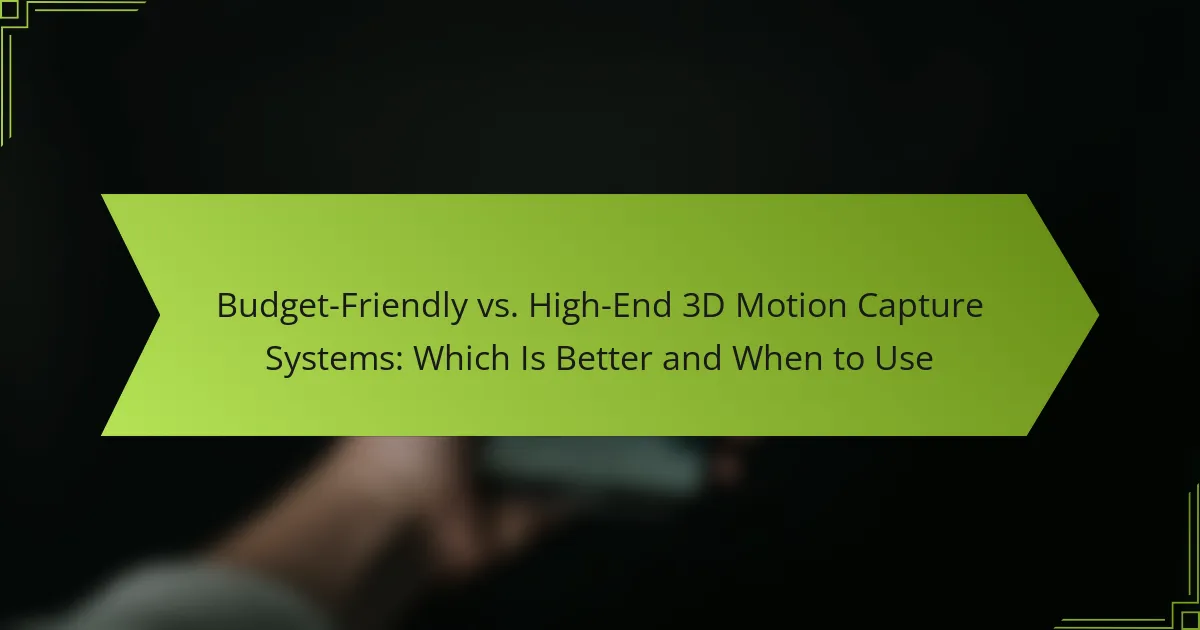When deciding between budget-friendly and high-end 3D motion capture systems, it’s essential to consider your specific needs and project requirements. Budget-friendly options provide a cost-effective solution for smaller studios and independent creators, while high-end systems deliver unparalleled precision and detail for professional applications in film, gaming, and biomechanics. Understanding when to use each type can help you achieve the best results without overspending.

What are budget-friendly 3D motion capture systems?
Budget-friendly 3D motion capture systems are affordable alternatives to high-end solutions, designed for smaller studios, independent creators, or educational institutions. They typically offer essential motion tracking capabilities without the high costs associated with professional-grade systems.
Examples of budget-friendly systems
Some popular budget-friendly 3D motion capture systems include the Perception Neuron, Xsens MVN Analyze, and Rokoko Smartsuit Pro. These systems are often priced in the low thousands of USD, making them accessible for many users.
Additionally, software-based solutions like Adobe Character Animator can provide motion capture features using standard webcams, further reducing costs for those on a tight budget.
Key features of budget-friendly systems
Budget-friendly systems generally focus on core functionalities such as real-time tracking, user-friendly interfaces, and compatibility with various animation software. They often utilize inertial sensors or optical tracking methods to capture movement accurately.
While these systems may lack some advanced features found in high-end models, such as extensive marker sets or high precision, they are suitable for many applications, including game development and animation projects. Users should consider the trade-offs in accuracy and range when selecting a system.
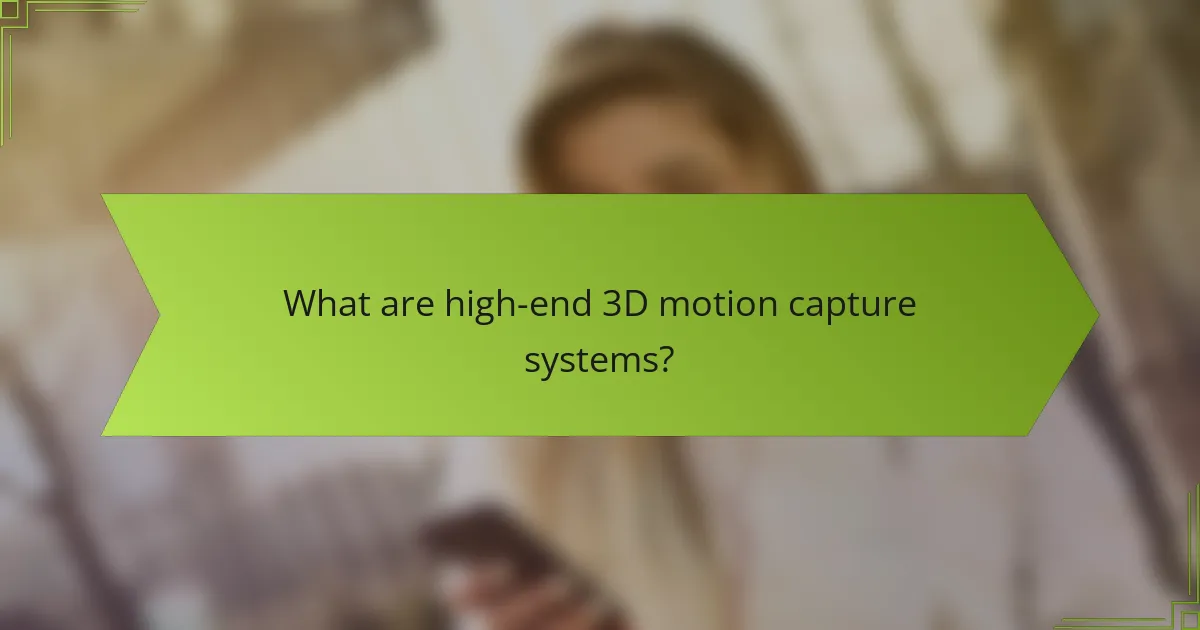
What are high-end 3D motion capture systems?
High-end 3D motion capture systems are advanced technologies used to track and record the movement of objects or people in three-dimensional space with high precision. These systems are typically employed in industries such as film, gaming, and biomechanics, where accuracy and detail are paramount.
Examples of high-end systems
Some notable examples of high-end 3D motion capture systems include Vicon, OptiTrack, and Motion Analysis. Vicon is widely used in film and sports analysis, while OptiTrack is known for its flexibility and scalability in various applications. Motion Analysis offers comprehensive solutions for biomechanics and animation.
Key features of high-end systems
High-end motion capture systems often feature high-resolution cameras, advanced tracking algorithms, and real-time data processing capabilities. These systems can capture motion with sub-millimeter accuracy and operate in various environments, including indoor and outdoor settings.
Additionally, they typically support a wide range of markers and sensors, allowing for detailed analysis of complex movements. Users can expect features like multi-camera setups, customizable software, and integration with other technologies, which enhance their versatility and effectiveness in professional settings.
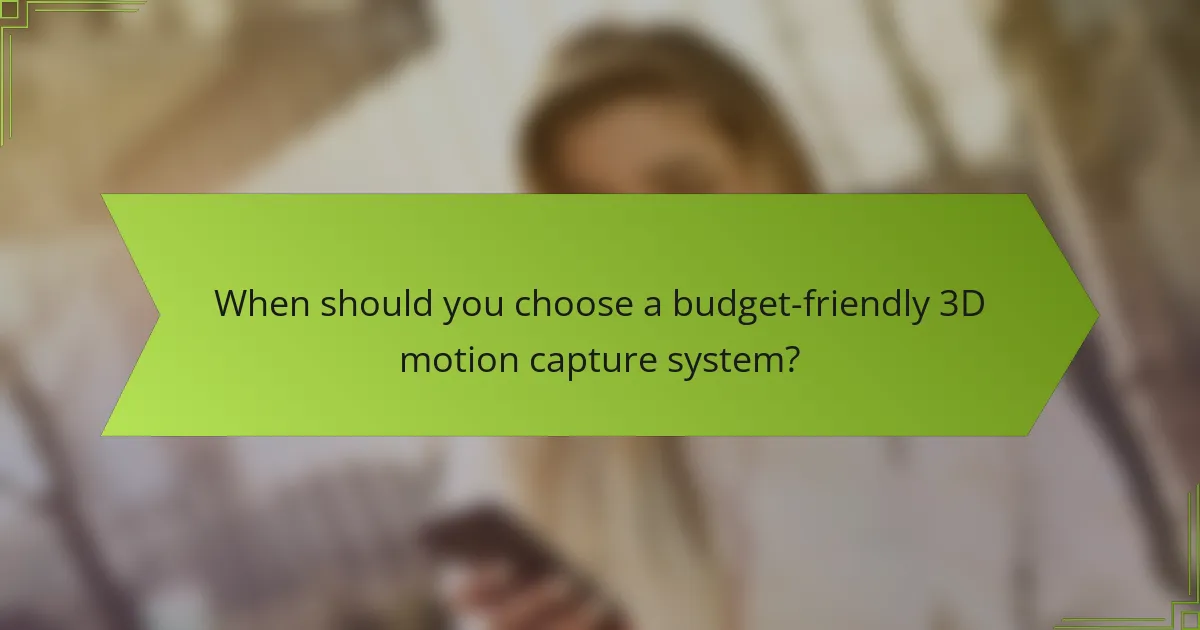
When should you choose a budget-friendly 3D motion capture system?
Choose a budget-friendly 3D motion capture system when you need to minimize costs while still achieving satisfactory results for less demanding projects. These systems are ideal for smaller studios, independent developers, or educational purposes where high-end features are not essential.
Best use cases for budget-friendly systems
Budget-friendly motion capture systems are well-suited for projects like indie game development, virtual reality experiences, and educational demonstrations. They provide sufficient accuracy for character animations and basic motion tracking without the high costs associated with professional-grade systems.
Additionally, these systems can be effective for prototyping and testing concepts where rapid iteration is key. For example, a small studio might use a budget-friendly setup to create a proof of concept before investing in more sophisticated technology.
Cost considerations for budget-friendly systems
When evaluating budget-friendly motion capture systems, consider the initial purchase price, which typically ranges from a few hundred to a few thousand USD. Keep in mind that lower-cost systems may have limitations in terms of tracking precision, number of cameras, and software capabilities.
Also, factor in ongoing costs such as software licenses, maintenance, and potential upgrades. It’s wise to assess whether the savings on equipment will be offset by any additional expenses in the long run, especially if your project scales up or requires more advanced features later on.
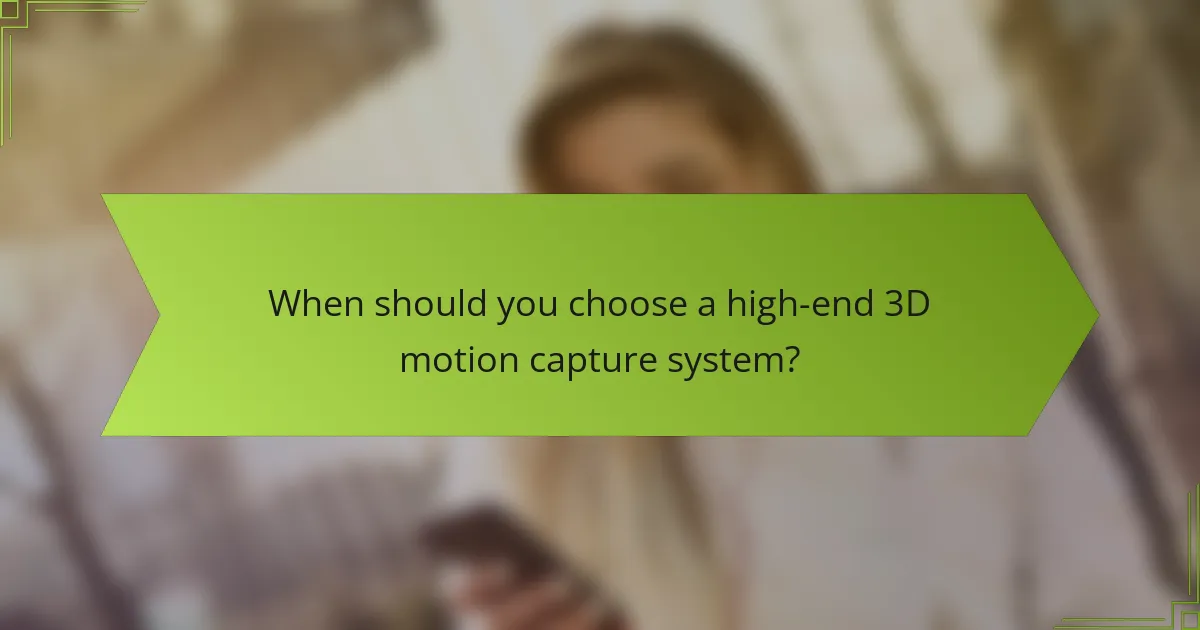
When should you choose a high-end 3D motion capture system?
High-end 3D motion capture systems are ideal when precision, accuracy, and advanced features are critical for your project. These systems are typically used in professional environments where the quality of motion data can significantly impact the final output, such as in film production, high-end gaming, and scientific research.
Best use cases for high-end systems
High-end motion capture systems excel in scenarios requiring detailed and accurate data, such as feature films, AAA video games, and virtual reality experiences. They are also beneficial in biomechanics research, where precise movement analysis is essential for studies and applications in sports science and rehabilitation.
Additionally, these systems often support complex setups, such as multi-camera configurations, allowing for capturing intricate movements in 3D space. This capability is crucial for projects that demand a high level of realism and fidelity.
Investment justification for high-end systems
Investing in a high-end 3D motion capture system can be justified by the potential return on investment through enhanced production quality and efficiency. While initial costs can be substantial, often ranging from tens of thousands to hundreds of thousands of dollars, the long-term benefits in terms of reduced post-production time and improved audience engagement can outweigh these expenses.
Moreover, high-end systems often come with robust support and software integration, which can streamline workflows and reduce the learning curve for teams. This makes them a worthwhile investment for studios and companies that rely on high-quality motion capture data to maintain competitive advantages in their respective fields.

What are the main differences between budget-friendly and high-end systems?
Budget-friendly 3D motion capture systems typically offer basic functionality at a lower price point, while high-end systems provide advanced features and superior performance for professional applications. The choice between them depends on your specific needs, such as the intended use, required accuracy, and available budget.
Performance comparison
Performance varies significantly between budget-friendly and high-end motion capture systems. Budget systems may have lower frame rates and tracking accuracy, often suitable for simple projects or educational purposes. In contrast, high-end systems deliver high frame rates, precise tracking, and robust data quality, making them ideal for professional film production or game development.
For example, budget systems might operate at around 30 frames per second (fps) with a tracking accuracy of a few centimeters, while high-end systems can achieve 120 fps or more with sub-millimeter accuracy. This difference can greatly impact the quality of the final output, especially in high-stakes environments.
Feature comparison
Budget-friendly systems often come with limited features, such as fewer cameras or basic software for data processing. They may lack advanced functionalities like real-time feedback, extensive customization options, or support for multiple actors. High-end systems, however, typically include a comprehensive suite of features, including advanced algorithms for data smoothing, extensive integration capabilities, and support for various motion capture techniques.
When choosing between the two, consider what features are essential for your projects. If you need multi-actor tracking or high fidelity in motion capture, investing in a high-end system is advisable. Conversely, for smaller projects or learning purposes, a budget-friendly option may suffice.

How to evaluate your needs for 3D motion capture?
Evaluating your needs for 3D motion capture involves understanding your project requirements, budget constraints, and the intended application of the captured data. This assessment will help you determine whether a budget-friendly or high-end system is more suitable for your purposes.
Criteria for selecting a system
When selecting a 3D motion capture system, consider factors such as accuracy, ease of use, and the specific features required for your project. High-end systems often provide superior precision and advanced capabilities, while budget-friendly options may suffice for simpler applications.
Think about the environment where the system will be used. For example, optical systems require controlled lighting conditions, while inertial systems can function in various settings. Assessing your working environment will guide you toward the right technology.
Budget considerations
Your budget plays a critical role in determining which motion capture system to choose. Budget-friendly systems typically range from a few thousand to tens of thousands of USD, while high-end systems can exceed hundreds of thousands. Establishing a clear budget will help narrow down your options effectively.
Keep in mind additional costs such as software licenses, maintenance, and potential upgrades. For instance, while a lower-priced system may seem appealing, hidden costs can add up, making it less economical in the long run. Always factor in the total cost of ownership when making your decision.
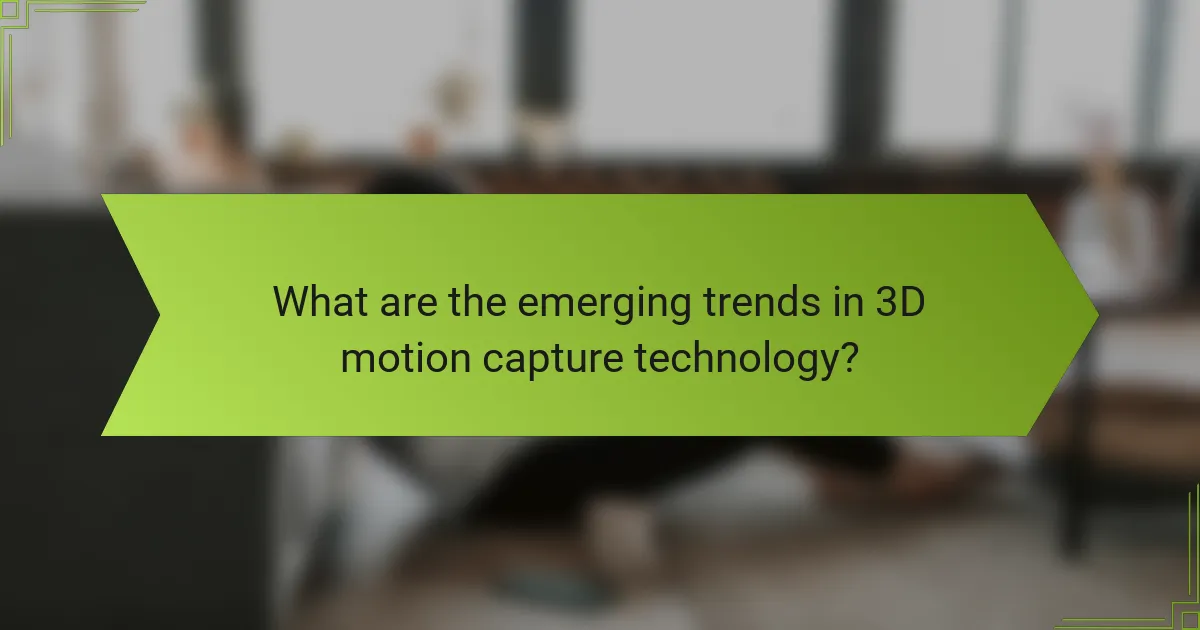
What are the emerging trends in 3D motion capture technology?
Emerging trends in 3D motion capture technology include enhanced software integration, improved affordability, and the use of artificial intelligence. These advancements are making motion capture more accessible and efficient for various applications, from gaming to healthcare.
Advancements in software integration
Recent advancements in software integration have streamlined the process of capturing and analyzing motion data. New platforms allow for seamless compatibility with various hardware systems, enabling users to easily transfer data between devices and software applications.
For example, many modern motion capture systems now offer real-time data processing, which significantly reduces the time needed to analyze movements. This is particularly beneficial in industries like film and gaming, where quick turnaround times are essential.
Future of affordability in motion capture systems
The future of affordability in motion capture systems looks promising, as competition among manufacturers drives prices down. Budget-friendly options are increasingly available, making it feasible for smaller studios and independent developers to invest in this technology.
As a result, users can expect to find systems priced in the low thousands of USD that still offer decent accuracy and functionality. However, it’s crucial to evaluate the specific needs of your project to ensure that a lower-cost system meets your requirements without sacrificing quality.
